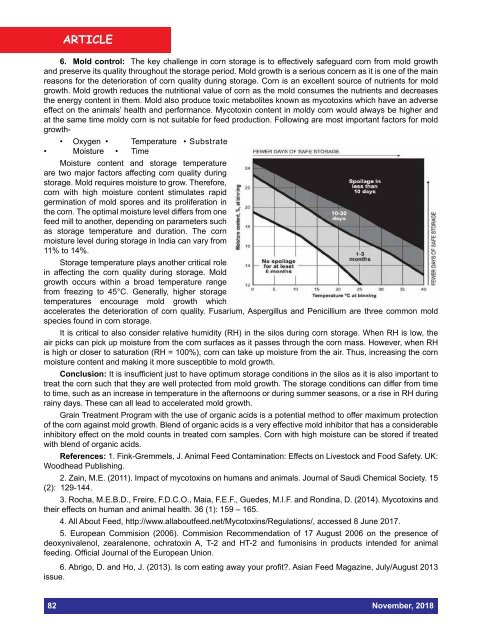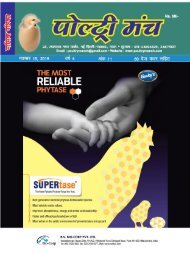November 2018 Punch PDF
You also want an ePaper? Increase the reach of your titles
YUMPU automatically turns print PDFs into web optimized ePapers that Google loves.
ARTICLE<br />
6. Mold control: The key challenge in corn storage is to effectively safeguard corn from mold growth<br />
and preserve its quality throughout the storage period. Mold growth is a serious concern as it is one of the main<br />
reasons for the deterioration of corn quality during storage. Corn is an excellent source of nutrients for mold<br />
growth. Mold growth reduces the nutritional value of corn as the mold consumes the nutrients and decreases<br />
the energy content in them. Mold also produce toxic metabolites known as mycotoxins which have an adverse<br />
effect on the animals’ health and performance. Mycotoxin content in moldy corn would always be higher and<br />
at the same time moldy corn is not suitable for feed production. Following are most important factors for mold<br />
growth-<br />
• Oxygen • Temperature • Substrate<br />
• Moisture • Time<br />
Moisture content and storage temperature<br />
are two major factors affecting corn quality during<br />
storage. Mold requires moisture to grow. Therefore,<br />
corn with high moisture content stimulates rapid<br />
germination of mold spores and its proliferation in<br />
the corn. The optimal moisture level differs from one<br />
feed mill to another, depending on parameters such<br />
as storage temperature and duration. The corn<br />
moisture level during storage in India can vary from<br />
11% to 14%.<br />
Storage temperature plays another critical role<br />
in affecting the corn quality during storage. Mold<br />
growth occurs within a broad temperature range<br />
from freezing to 45°C. Generally, higher storage<br />
temperatures encourage mold growth which<br />
accelerates the deterioration of corn quality. Fusarium, Aspergillus and Penicillium are three common mold<br />
species found in corn storage.<br />
It is critical to also consider relative humidity (RH) in the silos during corn storage. When RH is low, the<br />
air picks can pick up moisture from the corn surfaces as it passes through the corn mass. However, when RH<br />
is high or closer to saturation (RH = 100%), corn can take up moisture from the air. Thus, increasing the corn<br />
moisture content and making it more susceptible to mold growth.<br />
Conclusion: It is insufficient just to have optimum storage conditions in the silos as it is also important to<br />
treat the corn such that they are well protected from mold growth. The storage conditions can differ from time<br />
to time, such as an increase in temperature in the afternoons or during summer seasons, or a rise in RH during<br />
rainy days. These can all lead to accelerated mold growth.<br />
Grain Treatment Program with the use of organic acids is a potential method to offer maximum protection<br />
of the corn against mold growth. Blend of organic acids is a very effective mold inhibitor that has a considerable<br />
inhibitory effect on the mold counts in treated corn samples. Corn with high moisture can be stored if treated<br />
with blend of organic acids.<br />
References: 1. Fink-Gremmels, J. Animal Feed Contamination: Effects on Livestock and Food Safety. UK:<br />
Woodhead Publishing.<br />
2. Zain, M.E. (2011). Impact of mycotoxins on humans and animals. Journal of Saudi Chemical Society. 15<br />
(2): 129-144.<br />
3. Rocha, M.E.B.D., Freire, F.D.C.O., Maia, F.E.F., Guedes, M.I.F. and Rondina, D. (2014). Mycotoxins and<br />
their effects on human and animal health. 36 (1): 159 – 165.<br />
4. All About Feed, http://www.allaboutfeed.net/Mycotoxins/Regulations/, accessed 8 June 2017.<br />
5. European Commision (2006). Commision Recommendation of 17 August 2006 on the presence of<br />
deoxynivalenol, zearalenone, ochratoxin A, T-2 and HT-2 and fumonisins in products intended for animal<br />
feeding. Official Journal of the European Union.<br />
6. Abrigo, D. and Ho, J. (2013). Is corn eating away your profit?. Asian Feed Magazine, July/August 2013<br />
issue.<br />
82 <strong>November</strong>, <strong>2018</strong>





